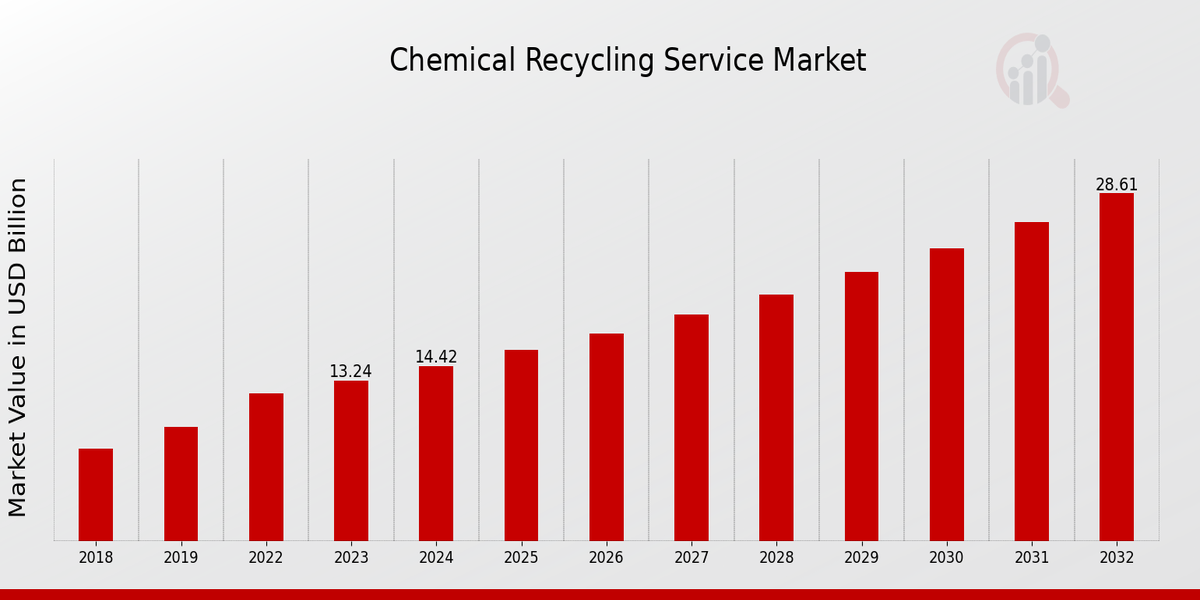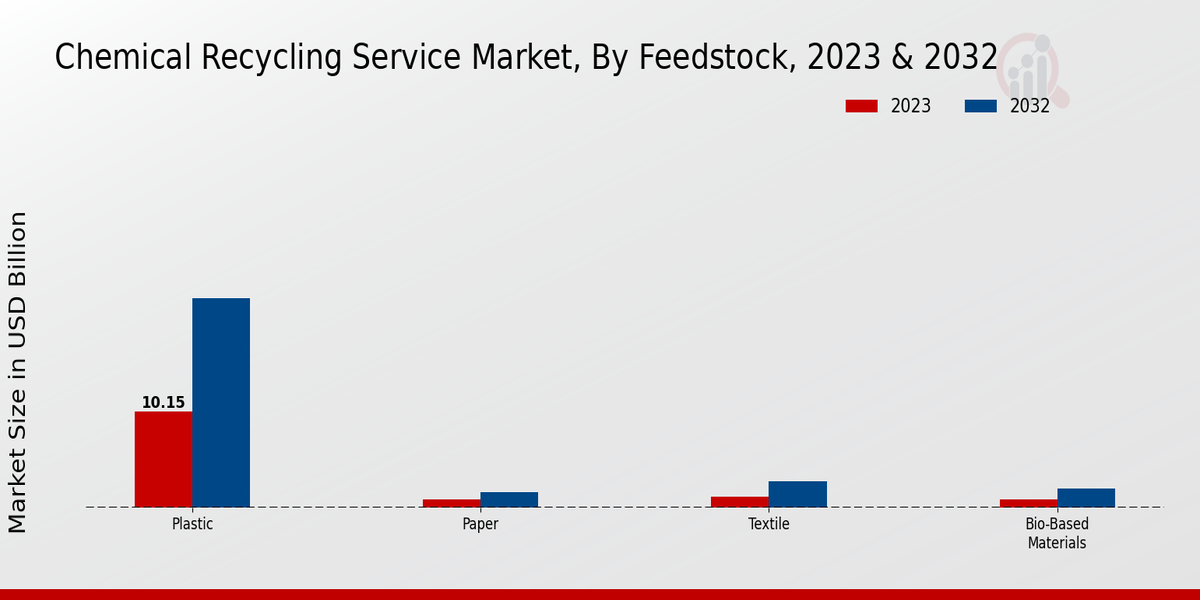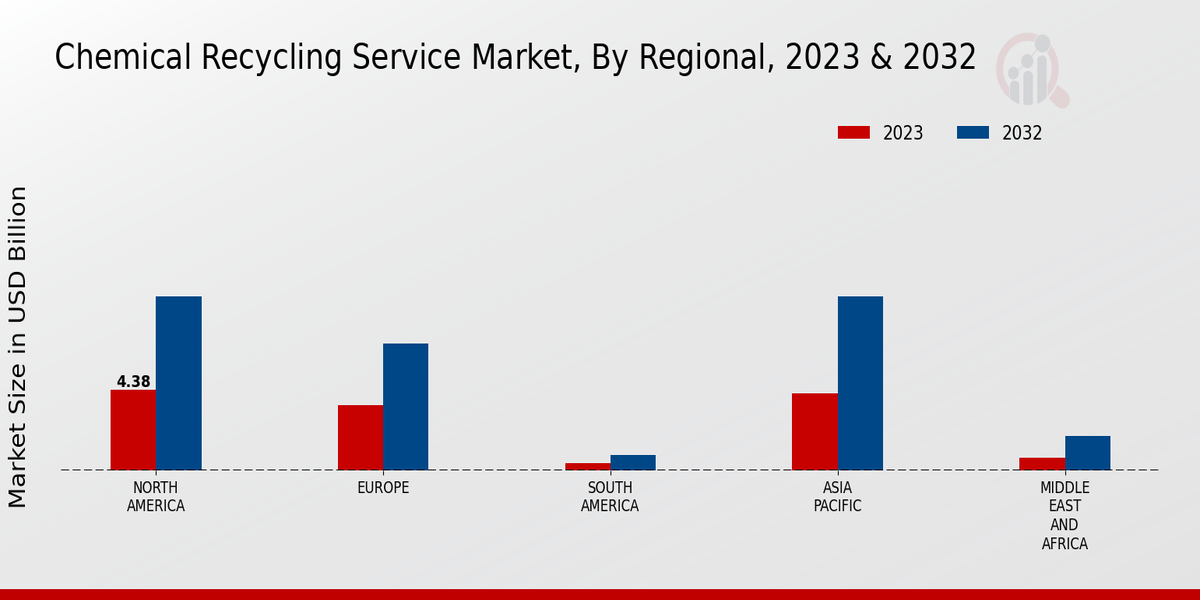Chemical Recycling Service Market Overview
As per MRFR analysis, the chemical recycling service market size was estimated at 15.71 (USD Billion) in 2024. The chemical recycling service market industry is expected to grow from 17.11 (USD Billion) in 2025 to 36.99 (USD Billion) by 2034. The chemical recycling service market CAGR (growth rate) is expected to be around 8.9% during the forecast period (2025 - 2034).
Key Chemical Recycling Service Market Trends Highlighted
The growing concerns over plastic pollution and stringent government regulations are driving the demand for chemical recycling services. This technology offers a sustainable solution by converting waste plastics into valuable raw materials, reducing the environmental impact and promoting circularity.
Chemical recycling involves breaking down polymers into their original monomers or other useful chemicals through various processes such as pyrolysis, gasification, and depolymerization. This process allows to produce new plastics, fuels, and other products, reducing the reliance on fossil fuels and decreasing landfill waste.
Key market drivers include the increasing adoption of sustainability initiatives by businesses and consumers, technological advancements in chemical recycling processes, and supportive government policies. Opportunities lie in exploring innovative technologies to improve the efficiency and cost-effectiveness of chemical recycling, as well as capturing new markets for recycled products.
Recent trends include the emergence of advanced feedstock sorting and pretreatment technologies, collaborations between chemical recyclers and plastic manufacturers, and the development of bio-based feedstocks for chemical recycling.

Source: Primary Research, Secondary Research, MRFR Database and Analyst Review
Chemical Recycling Service Market Drivers
Growing Demand for Sustainable Waste Management
The rising awareness of the environmental impact of plastic waste and the increasing need for sustainable waste management practices are driving the growth of the chemical recycling service market. Chemical recycling offers a viable solution for converting plastic waste into valuable resources, reducing the environmental footprint and promoting circular economy models.
Governments and organizations worldwide are implementing regulations and initiatives to promote sustainable waste management and reduce plastic pollution, creating a favorable market environment for chemical recycling services.
Technological Advancements in Chemical Recycling Processes
The chemical recycling service market is witnessing significant advancements in chemical recycling technologies. Innovations in catalysis, feedstock pre-treatment, and product purification are enhancing the efficiency and cost-effectiveness of chemical recycling processes.
These advancements enable the processing of a wider range of plastic waste materials, including complex and mixed plastics, and the production of higher-quality recycled materials. The development of new chemical recycling technologies is expected to further drive market growth and expand the applications of recycled plastic materials.
Increasing Investment in Chemical Recycling Infrastructure
The growing demand for chemical recycling services is attracting significant investments in the development of new and expanded chemical recycling facilities. Governments, private companies, and investors are recognizing the potential of chemical recycling as a sustainable and profitable industry.
The establishment of new chemical recycling plants and the expansion of existing facilities are increasing the capacity for chemical recycling, enabling the processing of larger volumes of plastic waste and meeting the growing demand for recycled materials.
Chemical Recycling Service Market Segment Insights
Chemical Recycling Service Market Feedstock Insights
The feedstock segment is a critical component of the chemical recycling service market, as it encompasses the various materials that are processed and converted into valuable products through chemical recycling processes. Key feedstocks in this segment include plastic, paper, textile, and bio-based materials.
Plastic constitutes a significant portion of the feedstock segment, owing to the increasing generation of plastic waste and the need for sustainable waste management solutions. Chemical recycling technologies offer an effective means of converting plastic waste into valuable resources, reducing its environmental impact and contributing to the circular economy.
Paper is another important feedstock in the chemical recycling service market. The growing demand for paper and paper-based products, coupled with environmental concerns, is driving the adoption of chemical recycling technologies that can process and recover paper waste, minimizing its contribution to landfills and promoting resource efficiency.
Textile waste is another major contributor to the feedstock segment. The fashion industry generates substantial amounts of textile waste, and chemical recycling technologies provide a sustainable solution for converting these discarded textiles into reusable materials, reducing their environmental footprint and promoting a circular textile economy.
Bio-based materials, such as plant biomass and agricultural residues, are also gaining traction as feedstocks for chemical recycling. The feedstock segment is expected to play a pivotal role in this growth, driven by the increasing demand for sustainable waste management solutions, the need to reduce environmental pollution, and the growing adoption of circular economy principles across various industries.

Source: Primary Research, Secondary Research, MRFR Database and Analyst Review
Chemical Recycling Service Market Technology Insights
The chemical recycling service market is segmented into various technologies, including mechanical recycling, chemical recycling, pyrolysis, and gasification. Among these, mechanical recycling currently dominates the market, accounting for a significant share of the chemical recycling service market revenue.
Mechanical recycling involves physically breaking down plastic waste into smaller pieces, which can then be reused or reprocessed. Chemical recycling, on the other hand, utilizes chemical processes to convert plastic waste into new materials or fuels.
Pyrolysis and gasification are advanced technologies that involve heating plastic waste in the absence of oxygen to produce valuable products such as syngas, bio-oil, and char. The Chemical Recycling Service Market is expected to witness significant growth in the coming years, driven by increasing environmental concerns and the need for sustainable waste management solutions.
Chemical Recycling Service Market End-Use Industry Insights
The end-use industry segment of the chemical recycling service market is categorized into several key industries, including automotive, packaging, consumer products, and construction. Each industry presents unique opportunities and challenges for chemical recycling services.
In the automotive industry, chemical recycling plays a crucial role in reducing the environmental impact of plastic components and materials used in vehicle manufacturing. The growing demand for sustainable and lightweight vehicles is driving the adoption of chemical recycling technologies to recover and reuse valuable materials from end-of-life vehicles.
The packaging industry is another significant end-use segment for chemical recycling services. With the increasing focus on reducing plastic waste and promoting circular economy models, chemical recycling offers a viable solution for recovering and reusing packaging materials. Chemical recycling technologies can effectively process multilayer and complex packaging materials, enabling the recovery of valuable feedstock for new packaging applications.
The consumer products industry also presents a substantial market for chemical recycling services. Chemical recycling technologies can be employed to process a wide range of consumer products, including electronics, appliances, and toys, to recover valuable materials and reduce waste. The growing awareness among consumers about sustainability and responsible disposal practices is driving the demand for chemical recycling services in this segment.
The construction industry offers significant potential for chemical recycling services, particularly in the recycling of construction and demolition waste. Chemical recycling technologies can effectively process various construction materials, such as plastics, metals, and concrete, to recover valuable resources and reduce the environmental impact of construction activities.
Overall, the end-use industry segment of the chemical recycling service market is expected to witness robust growth in the coming years, driven by the increasing demand for sustainable and circular economy solutions across various industries. The adoption of chemical recycling technologies will enable industries to reduce their environmental footprint, recover valuable materials, and contribute to a more sustainable future.
Chemical Recycling Service Market Scale of Operation Insights
The chemical recycling service market is segmented by scale of operation into small-scale, medium-scale, and large-scale. Small-scale operations typically involve recycling facilities that process less than 10,000 tons of plastic waste per year. These facilities are often located in rural areas or developing countries, and they typically use manual or semi-automated processes. The small-scale operations segment is expected to grow at a CAGR of 9.5% from 2023 to 2032, reaching a value of USD 4.5 billion by 2032.
Medium-scale operations typically involve recycling facilities that process between 10,000 and 50,000 tons of plastic waste per year. These facilities are typically located in urban areas or developed countries, and they typically use automated processes.
The medium-scale operations segment is expected to grow at a CAGR of 10.5% from 2023 to 2032, reaching a value of USD 7.8 billion by 2032. Large-scale operations typically involve recycling facilities that process more than 50,000 tons of plastic waste per year.
These facilities are typically located in major metropolitan areas, and they typically use highly automated processes. The market for large-scale operations is expected to grow at a CAGR of 11.5% from 2023 to 2032, reaching a value of USD 16.3 billion by 2032.
The growth of the chemical recycling service market is being driven by many factors, including the increasing demand for recycled plastic products, the rising cost of landfill disposal, and the growing awareness of the environmental impact of plastic pollution.
Chemical Recycling Service Market Regional Insights
The chemical recycling service market is expected to grow significantly over the next decade, driven by increasing demand for sustainable waste management solutions and government regulations promoting circular economy initiatives. The regional landscape of the market is diverse, with each region presenting unique growth opportunities and challenges.
North America holds a dominant position in the chemical recycling service market, accounting for a substantial share of the revenue. The region's robust chemical industry and stringent environmental regulations have fostered a favorable environment for the adoption of chemical recycling technologies.
Europe is another key market for chemical recycling services, with a growing emphasis on resource efficiency and waste reduction. The region is home to several leading chemical companies and research institutions that are actively investing in chemical recycling solutions.
Asia-Pacific (APAC) is anticipated to witness significant growth in the chemical recycling service market, driven by rapid industrialization and increasing environmental awareness. China, Japan, and India are expected to be major contributors to the region's market growth. South America and the Middle East and Africa (MEA) represent emerging markets for chemical recycling services.
These regions have the potential for significant market growth as they seek to address growing waste management challenges and adopt more sustainable practices. Overall, the chemical recycling service market is expected to continue to expand rapidly in the coming years, driven by increasing demand for sustainable solutions, favorable government policies, and technological advancements.

Source: Primary Research, Secondary Research, MRFR Database and Analyst Review
Chemical Recycling Service Market Key Players and Competitive Insights:
Major players in the chemical recycling service market are focusing on expanding their presence and increasing their market share. They are also investing in research and development to develop new and innovative technologies. Leading players are adopting strategies such as acquisitions, joint ventures, and partnerships to strengthen their position in the market.
The landscape is expected to witness significant growth in the coming years, owing to increasing demand for sustainable and eco-friendly solutions. Chemical recycling service market development is driven by factors such as rising environmental concerns, government regulations, and technological advancements.
One of the leading players in the chemical recycling service market is Mura Technology. The company is headquartered in the United Kingdom and has operations in several countries. Mura Technology provides a range of chemical recycling services, including plastic recycling, waste management, and energy recovery. The company has a strong track record of innovation and has developed a number of patented technologies. Mura Technology is a major supplier to the automotive, packaging, and consumer goods industries.
A major competitor in the Chemical Recycling Service Market is Plastic Energy. The company is headquartered in the United Kingdom and has operations in several countries. Plastic Energy provides a range of chemical recycling services, including plastic recycling, waste management, and energy recovery. The company has a strong focus on sustainability and has developed several innovative technologies. Plastic Energy is a major supplier to the automotive, packaging, and consumer goods industries.
Key Companies in the Chemical Recycling Service Market Include:
Chemical Recycling Service Market Industry Developments
The chemical recycling service market is projected to reach USD 28.6 billion by 2032, exhibiting a CAGR of 8.94% during the forecast period. Key factors driving market growth include increasing demand for recycled plastics, rising environmental concerns, and supportive government regulations.
Recent developments include collaborations between chemical recycling companies and major petrochemical players, such as SABIC and LyondellBasell, to scale up production and commercialize chemically recycled plastics.
Technological advancements, such as the development of new catalysts and processes, are also contributing to market growth. The market is expected to witness significant growth in the Asia-Pacific region due to the presence of large plastic waste generators and supportive government policies.
Chemical Recycling Service Market Segmentation Insights
Chemical Recycling Service Market Feedstock Outlook
Chemical Recycling Service Market Technology Outlook
Chemical Recycling Service Market End-Use Industry Outlook
Chemical Recycling Service Market Scale of Operation Outlook
Chemical Recycling Service Market Regional Outlook
| Report Attribute/Metric |
Details |
| Market Size 2024 |
17.11 (USD Billion) |
| Market Size 2025 |
17.11 (USD Billion) |
| Market Size 2034 |
36.99 (USD Billion) |
| Compound Annual Growth Rate (CAGR) |
8.9% (2025 - 2034) |
| Report Coverage |
Revenue Forecast, Competitive Landscape, Growth Factors, and Trends |
| Base Year |
2024 |
| Market Forecast Period |
2025 - 2034 |
| Historical Data |
2020 - 2024 |
| Market Forecast Units |
USD Billion |
| Key Companies Profiled |
SABIC, Borealis AG, BASF SE, Shell plc, LyondellBasell Industries Holdings B.V., Covestro AG, Reliance Industries Limited, EXXONMOBIL CORPORATION, Agilyx Corporation, INEOS, Nova Chemicals Corporation, Eastman Chemical Company, Dow Chemical Company, TotalEnergies SE, Chevron, Phillips Chemical Company LLC |
| Segments Covered |
Feedstock, Technology, End-Use Industry, Scale of Operation, Region |
| Key Market Opportunities |
Growing Demand for Sustainable Packaging Advances in Technology Enhancing Efficiency Government Initiatives and Regulations Partnerships and Collaborations Driving Innovation Expanding Application in Various Industries |
| Key Market Dynamics |
Increasing Environmental Concerns Growth in Plastic Production Technological Advancements Government Regulations Rising Demand for Sustainable Packaging |
| Countries Covered |
North America, Europe, APAC, South America, MEA |
Frequently Asked Questions (FAQ) :
The chemical recycling service market is expected to reach a valuation of USD 17.11 billion in 2025, expanding to USD 36.99 billion by 2034, exhibiting a CAGR of 8.9% during the forecast period (2025-2034).
The Asia-Pacific region dominates the chemical recycling service market and is expected to maintain its dominance throughout the forecast period. Other key regions include North America, Europe, and the Rest of the World (RoW).
Growing environmental concerns, rising demand for sustainable packaging solutions, and government regulations promoting circular economy practices are the primary drivers fueling the growth of the chemical recycling service market.
Chemical recycling services find applications in various industries, including plastics, textiles, and electronics. These services enable the conversion of waste materials into valuable resources, promoting sustainability and reducing environmental impact.
Key players in the chemical recycling service market include BASF SE, SABIC, LyondellBasell Industries Holdings B.V., Dow Inc., and Eastman Chemical Company. These companies offer a range of chemical recycling technologies and services, catering to diverse industry needs.
The chemical recycling service market faces challenges related to high operating costs, technological limitations, and the availability of feedstock. Additionally, the market is influenced by fluctuating oil prices and evolving regulatory landscapes.
The growing adoption of circular economy models, advancements in chemical recycling technologies, and increasing investments in sustainable infrastructure present significant opportunities for growth in the chemical recycling service market.
The chemical recycling service market is projected to grow at a CAGR of 8.9% during the forecast period from 2025 to 2034.
Key trends in the chemical recycling service market include the integration of advanced technologies, such as artificial intelligence and machine learning, to optimize processes and improve efficiency. Additionally, the market is witnessing a shift towards decentralized chemical recycling facilities to enhance accessibility and reduce transportation costs.
The regulatory landscape for the chemical recycling service market varies across different regions. Governments worldwide are implementing regulations to promote circular economy practices and reduce plastic waste. These regulations include extended producer responsibility schemes, landfill bans, and targets for recycled content in products.

















